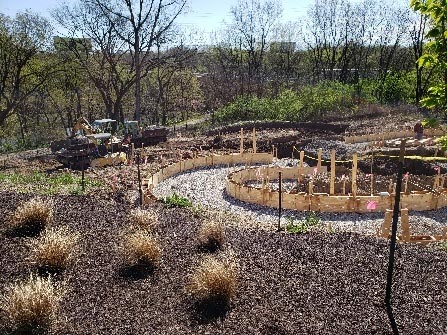Waterfront Botanical Gardens
Louisville, KY
The Waterfront Botanical Gardens in Louisville, Kentucky, has an intriguing vision – “Planting seeds and growing minds for more sustainable cities.” In 2009, they embarked upon a major endeavor to move that vision forward. The Gardens purchased a former 23-acre landfill near the Ohio River for their new location. The landfill had been capped and closed in the 1970s according to federal requirements, but due diligence was still necessary before the site could be redeveloped.
Patriot was selected to provide environmental services for the project. The environmental work was funded by the USEPA Petroleum Grant Program through the Kentucky Brownfield Redevelopment Program.

Patriot’s Work Included:
- Review of the site history and previous environmental reports including a Phase I environmental site assessment (ESA) conducted by the Kentucky Department of Environmental Protection (KDEP) and several other Phase I and Phase II ESA reports prepared over the past 25 years
- Identification of clean-up alternatives for the site
- Development of a corrective action plan (CAP)
- Preparation of a quality assurance project plan (QAPP)
- Preparation of a site-specific health and safety plan (HASP)
Current Site Conditions
Patriot also conducted supplemental soil sampling and soil vapor sampling at the former landfill to obtain a better understanding of current site conditions. The sampling conducted in accordance with the QAPP. The data were compared to the USEPA Regional Screening Levels (RSL) for soil and soil vapor. The soil vapor sampling results were below the indoor air RSL. Soil samples were found to contain arsenic at concentrations above the RSL, but Patriot demonstrated that the arsenic levels were within background concentrations for Jefferson County and did not pose a significant risk to human health or the environment.
To evaluate possible clean-up alternatives, potential risks to human health and the environment, numerous remedial alternatives, the potential for use of engineering controls, and costs were all considered. Based on review of the site information and environmental data, it was determined that a soil cap with a management-in-place program using engineering and site controls would be implemented to minimize risk and address residual soil impacts. As part of the engineering controls, passive impermeable barriers would be installed during the construction of inhabited buildings. The engineering and site controls were provided in detail within the CAP for the site.
The Cap Presented the Following:
- A summary of site background information and current environmental site conditions
- An evaluation of appropriate cleanup alternatives to mitigate or manage the identified environmental conditions
- The selected corrective action alternatives and how they best meet the objectives and considerations of the project
- The implemented corrective actions, engineering controls, site management controls, monitoring programs, and maintenance programs to manage the controls
Throughout the project, Patriot acted as liaison between the Gardens management and KDEP through in-person meetings, conference calls, and email correspondence to provide timely communication of technical considerations. Following review of the CAP and QAPP, Patriot prepared additional information that the Gardens used to keep all stakeholders informed and to allow the project to continue on schedule.
The Waterfront Botanical Gardens is on a mission – “to cultivate urban botanical gardens that educate, inspire, and enhance appreciation of the relationship between plant life and a healthy environment.” Patriot is proud to be a part of helping them continue that mission.
